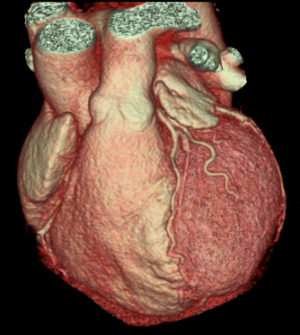by
Jean B. Grillo, Reporter | December 03, 2007

A 64-slice computed
tomography (CT) scan
of a heart.
When the New England Journal of Medicine reported last week on the dangers of increased use of computed tomography (CT), the news garnered front page coverage across the country.
However, in Chicago, at the annual Radiology Society of North America conference, held at the same time, the issue of growing CT scan use possibly leading to significant health problems was already well known. Original equipment manufacturers including GE, Toshiba, and Philips used the RSNA to debut possible solutions: Toshiba's Aquilion ONE; GE's futuristic Gemstone High-Definition CT Scanner along with existing systems, and Philips' Brilliance iCT scanner, technologies that limit radiation exposure.
The NEJM study by Columbia University Medical Center found that radiation doses to organs from a common CT study probably result in an increased risk of cancer particularly for children. CT scans may be to blame for up to 2% of cancers in the U.S. over the next few decades. The understanding is partly based on long-term observations of lifetime risk of radiation exposure among atom bomb survivors. While individual risk is low, an increased use of CT would impart a greater overall health risk to the population. The study contributes to the case being made that we use CT scanning too often.



Ad Statistics
Times Displayed: 7181
Times Visited: 166 Keep biomedical devices ready to go, so care teams can be ready to care for patients. GE HealthCare’s ReadySee™ helps overcome frustrations due to lack of network and device visibility, manual troubleshooting, and downtime.
While large-scale studies are needed, ECRI Institute had reported earlier this year in DOTmed News that CT scans may account for up to 6,000 U.S. cancers per year and CT use is on the rise. Alarmingly, clinicians and patients seem to lack a clear understanding of the risk.
CT scans are an X-ray-based tool providing three-dimensional views of a particular organ or tissue. Its ability to successfully diagnose injury, cancer and other health problems is undisputed.
David Brenner, PhD and Eric Hall, PhD, from the Center of Radiological Research at Columbia University, underscore in their NEJM presentation much of what the ECRI research also argued: potential carcinogenic efforts from CT scan use "may be underestimated or overlooked." Adding to everyone's concern are data noting a marked increase in the average personal radiation exposure in the United States, growing from an estimated three million CT scans a year in 1980 to more than 62 million currently.
CT scans result in far larger doses than conventional plain-film X-ray exposure. Early belief held that all radiological examinations were essentially harmless because of the small amounts of radiation involved. But Drs. Brenner and Hall note that sixty years of CT scans study, specifically of Japanese atomic bomb survivors two miles away from the explosions, reveal that radiation doses for them were quite similar to those from a CT scan, representing a potential public health problem. "In a few decades," the authors say, "about 1.5 to 2 percent of all cancers in the United States may be due to radiation from CT scans being done now."

